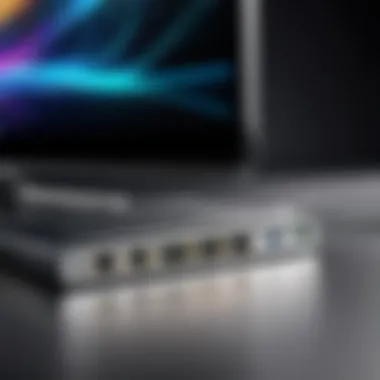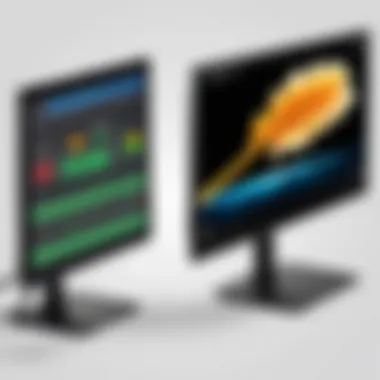Exploring USB-C Monitors with Ethernet: A Comprehensive Guide


Intro
In recent years, the use of USB-C monitors with Ethernet capabilities has emerged as a significant consideration for IT professionals and tech enthusiasts. These monitors offer a blend of convenience and performance, addressing the increasing demand for streamlined connectivity solutions in modern work environments. This guide will explore various aspects of USB-C monitors that include Ethernet features. By analyzing key attributes, technical specifications, and real-world applications, we seek to aid professionals in making informed decisions when integrating these monitors into their setups.
USB-C technology has transformed the way devices connect to one another. By providing a single port for both power and data transfer, it simplifies connections between monitors, laptops, and other peripherals. Coupling this with Ethernet connectivity allows for improved internet access without needing additional cables, creating a more organized and efficient workspace.
This article aims to provide an in-depth examination of the advantages and challenges associated with USB-C monitors with Ethernet, catering specifically to the expertise of IT professionals. We will cover compatibility issues, use scenarios, and future trends to offer a well-rounded understanding of this technology.
Intro to USB-C Monitors with Ethernet
The emergence of USB-C monitors with Ethernet marks a significant evolution in display technology. These devices combine video output and data transmission capabilities, offering a streamlined solution for various professional applications. Understanding their functionalities and benefits is crucial for IT professionals looking to enhance their workflows.
Defining USB-C Technology
USB-C technology, also known as USB Type-C, is a universal connectivity standard. It allows for data transfer, display output, and charging through a single, reversible connector. This feature significantly reduces the number of cables needed for connectivity in a workspace, leading to a cleaner environment.
Moreover, USB-C supports high data transfer speeds up to 10 Gbps or more, depending on the version, making it suitable for demanding applications. As more devices adopt this standard, the importance of USB-C monitors continues to grow, allowing for greater interoperability among gadgets.
Understanding Ethernet Connectivity
Ethernet connectivity facilitates network communication through wired connections. Integrating Ethernet into USB-C monitors enhances their usefulness in office settings where reliable internet access is required. Unlike wireless connections, Ethernet offers stability and speed that is crucial for tasks such as video conferencing or large file transfers.
Having a USB-C monitor with built-in Ethernet allows users to connect to corporate networks directly, ensuring a stable connection without needing additional adapters. This feature eliminates the hassle of managing multiple cables, improving the overall efficiency of the work environment.
"The integration of USB-C and Ethernet is changing the way professionals approach their connectivity needs."
As USB-C monitors with Ethernet become more prevalent, they represent a confluence of modern technology trends. The ability to bridge both display and network capabilities addresses the growing demand for versatile and efficient workstations.
Technical Specifications of USB-C Monitors
Understanding the technical specifications of USB-C monitors is essential for IT professionals and tech enthusiasts alike. The performance of monitors can significantly impact productivity and user experience. Knowing what to look for ensures you select the right monitor to meet specific needs.
Resolution and Display Quality
The resolution of a monitor determines how sharp and detailed the images appear. Common resolutions for USB-C monitors include Full HD (1920x1080), Quad HD (2560x1440), and 4K Ultra HD (3840x2160). Higher resolutions provide better clarity, which is crucial for tasks like graphic design and video editing.
- Full HD is often sufficient for general office work.
- Quad HD offers a middle ground, with increased detail and clarity, ideal for multitasking.
- 4K is preferred for professional use, particularly in industries where precise detail matters.
Display quality also depends on factors like brightness, contrast ratio, and panel type. For example, an IPS panel generally provides better color accuracy and viewing angles compared to a TN panel, making it more suitable for design work.
Refresh Rate Considerations
Refresh rate refers to how many times per second the monitor updates the image on the screen. It's measured in hertz (Hz). A standard refresh rate is 60Hz, but many monitors now offer higher rates like 120Hz or even 240Hz.


- 60Hz is adequate for general use.
- 120Hz and 240Hz are beneficial for gaming and fast-paced applications, reducing motion blur and providing smoother visuals.
With USB-C monitors, especially those with Ethernet ports, a higher refresh rate may require compatible devices to fully utilize the feature. It's crucial to ensure both the monitor and the connected device support higher refresh rates to avoid potential bottlenecks in performance.
Color Accuracy and Gamut
Color accuracy is vital for tasks that require visual precision, such as editing photos or videos. Monitors with high color accuracy provide realistic and vibrant colors.
The color gamut defines the range of colors a monitor can display. A monitor that can cover a wide color gamut, like Adobe RGB or DCI-P3, is typically sought after in creative fields.
When selecting a USB-C monitor:
- Look for monitors that specify their color accuracy metrics, such as Delta E values.
- Check for coverage of color spaces like sRGB, Adobe RGB, and DCI-P3.
Advantages of USB-C Monitors with Ethernet
Understanding the advantages of USB-C monitors with Ethernet is crucial for IT professionals and tech enthusiasts. These monitors bring a range of benefits that enhance usability, connectivity, and performance in various environments. The integration of both USB-C and Ethernet capabilities allows for a streamlined approach to device management and improves productivity.
Simplified Connections
One of the key advantages of USB-C monitors with Ethernet is the simplified connection process. With USB-C being a versatile interface, it can carry power, data, and video signals all through a single cable. This is particularly beneficial in a world where users often struggle with multiple cords and connectors. In many cases, connecting a monitor to a laptop or desktop can require several cables, including HDMI or DisplayPort for video and separate USB or Ethernet cables for data transfer. With USB-C, this becomes less complicated.
Additionally, the ability to use a single cable for various functions reduces the potential for connection errors and improves overall efficiency. It is important for professionals who value their workspace's neatness. Fewer cables mean less clutter on a desk, offering a cleaner appearance and potentially a more focused work environment.
Enhanced Data Transmission Speeds
USB-C monitors that support Ethernet capabilities can deliver outstanding data transmission speeds. These monitors can leverage the high bandwidth offered by USB-C, alongside fast Ethernet connectivity. This means that large files can be transferred rapidly between devices. Especially for professionals in graphic design or software development, this speed can make a significant difference in productivity.
The combination of these technologies allows for high-definition video streaming while maintaining fast data access. As demands for high-resolution content continue to rise, events like video conferencing or sharing large media files are done seamlessly. The integration of such capabilities minimizes buffering or lag, thus optimizing workflow.
"With USB-C, transcending the traditional limitations of connectivity leads to a more effective use of technological resources."
Reduced Cable Clutter
Lastly, one can't overlook the impact on cable management that USB-C monitors with Ethernet provide. A common complaint in many workspaces is the extensive number of cables required to manage multiple devices. USB-C's ability to centralize connections allows professionals to clear away excess wiring. This not only improves the physical environment, making it less chaotic but also enhances the overall usability of the workspace.
When fewer cables are present, the risk of accidents caused by tripping over wires or tangling connections diminishes. Additionally, USB-C monitors often come with additional ports that can extend connectivity options without the need for extra cables. For instance, some monitors include USB-A ports for peripherals, allowing a seamless connection to mice or keyboards without clutter.
Limitations of USB-C Monitors with Ethernet
The adoption of USB-C monitors with Ethernet connectivity comes with certain limitations that professionals in the information technology realm must be aware of. Understanding these drawbacks is essential for making informed decisions about integrating this technology into work environments. While the benefits of simplification and enhanced utility are evident, so too are the challenges that may arise during deployment and operation.
Compatibility Issues with Legacy Devices


One significant limitation is compatibility with older devices. Many legacy devices, such as older laptops or desktops, may lack USB-C ports entirely. This absence creates a barrier for users who might want to connect these devices to modern USB-C monitors. While adapters are available to bridge this gap, they can introduce additional complexity and may not always support the full range of features. Furthermore, reliance on adapters may limit functionalities like Ethernet connectivity and reduce overall performance. IT professionals therefore need to assess device compatibility rigorously before making infrastructure changes.
Potential Cost Implications
Investing in USB-C monitors with Ethernet can have considerable cost implications. While sourcing advanced monitors may offer superior features that justify the expense, the initial investment can be a barrier for some organizations. Additionally, the need to upgrade legacy devices or purchase adapters to ensure compatibility can inflate costs further. Maintenance and long-term support for newer technology can also lead to escalated operational expenses, making it essential for organizations to perform a cost-benefit analysis before embarking on such integrations. Factors influencing these costs can include brand preference, features offered, and market dynamics.
Dependence on USB-C Ports Availability
Another limitation involves the dependence on the availability of USB-C ports. Despite the growing prevalence of USB-C in newer devices, many existing systems still support other types of connections. This situation limits the immediate utility of USB-C monitors in mixed-technology environments. IT departments must consider how many devices currently in use are equipped with suitable ports. Without sufficient USB-C ports on devices, teams may find they cannot fully leverage the capabilities of their new monitors, ultimately negating the convenience offered by the all-in-one connection.
"Evaluating current infrastructure is a vital step for IT professionals before committing to USB-C monitors with Ethernet, as it impacts both usability and productivity across teams."
Compatibility Considerations
Compatibility is a crucial factor when considering USB-C monitors with Ethernet. Ensuring that these monitors integrate seamlessly with existing setups can have significant benefits. A good understanding of compatible devices and necessary software will enhance the experience and usability of these advanced monitors.
Compatible Devices
Several devices can work effectively with USB-C monitors equipped with Ethernet. The key to compatibility is the presence of USB-C ports with full capabilities. Here are some devices that typically support these monitors:
- Laptops: Many modern laptops from brands such as Apple, Dell, and HP come with USB-C ports that support various functionalities, including video output and data transfer.
- Tablets: Devices like the iPad Pro and Microsoft Surface Pro offer USB-C ports that can connect to monitors efficiently.
- Smartphones: Premium models like Samsung Galaxy S series and Google Pixel can sometimes be used to connect to USB-C monitors, allowing for larger displays without needing a computer.
- Docking Stations: Devices like the CalDigit TS3 Plus and Lenovo ThinkPad Docking Stations provide additional connectivity options, allowing multiple devices to be connected to a USB-C monitor simultaneously.
Determinining compatibility helps to avoid interruptions in workflow, especially in professional settings. A mismatch between devices and monitors can lead to problems, such as reduced functionality or inability to connect entirely.
Software Requirements
Apart from hardware compatibility, software must also be considered. USB-C monitors generally require specific drivers or operating systems that can manage their functionalities effectively.
- Operating Systems: Ensure the operating system is up-to-date. Windows 10 and macOS latest versions generally have good support for USB-C device functionalities.
- Display Drivers: Install and update display drivers regularly. Software from manufacturers like Nvidia or AMD can be helpful to optimize performance.
- Management Software: Certain advanced monitors may come with vendor-specific software to enable features such as screen layout customization and other functionalities. For example, Dell provides Display Manager to help manage their USB-C monitors effectively.
Addressing these software elements is essential to maintain smooth operation and full utilization of monitor features. Understanding both device and software compatibility can greatly enhance the user experience.
Use Cases in Professional Environments
USB-C monitors with Ethernet offer significant benefits for various professional environments. These modern devices streamline workflows, enhance productivity, and cater to the specific needs of different fields. Understanding their practical applications can assist IT professionals in selecting the right monitors that fit their requirements.
Graphic Design and Creative Work
In the field of graphic design, color accuracy and display quality are paramount. USB-C monitors equipped with Ethernet can support higher bandwidth and better data throughput. This is crucial for designers working with high-resolution images and graphics.
With USB-C, connecting to a laptop or workstation becomes more efficient. A single cable can transmit not only video signals but also data for external drives and internet connectivity. This enables a less cluttered workspace, allowing designers to focus on their craft without the distraction of multiple cables.
Moreover, many USB-C monitors offer color calibration features, which are essential for ensuring that designers see the precise colors they intend for their work.
Enhanced connectivity through Ethernet also supports faster uploads and downloads of design files, facilitating smoother collaboration among team members.
Software Development and Testing


Software developers can also greatly benefit from USB-C monitors with Ethernet connections. The ability to connect multiple devices is vital to any developer's workflow. With one port, they can easily dock laptops, access external storage, and maintain a stable internet connection.
Many developers need to view code on multiple screens simultaneously. A USB-C monitor can accommodate this need, often with features like daisy-chaining that allows more than one monitor to be connected in series.
This arrangement aids in debugging by providing a broader view of applications and system processes. Furthermore, the high-resolution outputs provided by these monitors improve the readability of code, making it easier to spot errors.
When discussing testing, the enhanced bandwidth can facilitate agile testing environments. Uninterrupted access to cloud services made possible by the Ethernet integration ensures timely feedback and updates, which is crucial in the rapidly evolving software market.
Remote Work and Collaborations
In the realm of remote work, USB-C monitors with Ethernet connectivity enhance collaboration significantly. As remote teams become more common, the need for effective communication and seamless workflows is critical. Monitors equipped with Ethernet optimize the performance of video conferencing tools.
A stable wired connection often reduces lag and enhances call quality, essential when presenting projects or holding team meetings.
Additionally, remote workers can benefit from the efficiency of having a single connection for data transfer and video output. This means less time fiddling with cables and more time focused on tasks at hand.
Future Trends in Monitor Technology
The landscape of monitor technology is continuously evolving, particularly with the advent of USB-C monitors equipped with Ethernet. These innovations not only enhance user experiences but also adapt to the changing needs of professionals in dynamic work environments. Understanding future trends is crucial for IT professionals who aim to stay informed about the latest technological advancements, ensuring their tools are up to date and aligned with modern requirements.
Advancements in USB-C Standards
USB-C technology has seen substantial advancements over the years. The introduction of USB4, for example, has brought significant improvements in data transfer speeds, as well as power delivery capabilities. This innovation allows a single USB-C connection to provide higher bandwidth and support multiple protocols, making it a versatile choice for modern monitors.
- Increased Data Transfer Rates: USB4 can achieve speeds of up to 40 Gbps, enabling large file transfers and seamless video streaming.
- Universal Compatibility: The compatibility with various devices simplifies the user experience. Professionals can connect laptops, tablets, and smartphones without needing multiple cables.
- Power Delivery Enhancements: Enhanced power delivery options allow monitoring devices to charge laptops simultaneously. This reduces the need for extra chargers and creates a more streamlined workspace.
These advancements suggest that USB-C monitors will continue to improve, maximizing efficiency and usability for busy professionals in various sectors.
Integration with Emerging Technologies
The integration of USB-C monitors with emerging technologies is another trend to watch. With the rise of 5G connectivity and advancements in AI, these monitors are set to play a robust role in tomorrow's workplaces.
- 5G Adoption: As 5G technology becomes more mainstream, USB-C monitors are likely to incorporate features that leverage high-speed internet access, allowing for high-definition streaming and real-time collaboration without lag.
- AI and Automation: The ability to connect multiple devices through USB-C allows AI systems to optimize resource allocation in professional settings. For instance, software could adjust display settings automatically based on the tasks being performed.
- Complex Workflows: As workflows become more complex, the need for versatile, multi-functional monitors grows. USB-C monitors equipped with Ethernet are positioned to handle multi-display setups, facilitating tasks that demand high levels of multitasking.
The End
The conclusion section is pivotal for synthesizing the insights presented throughout this article on USB-C monitors with Ethernet. It serves as a recap of the key points discussed, reinforcing the relevance of these monitors in today’s technology landscape. With the rapid evolution of work environments and the growing need for high-quality displays, understanding the benefits and limitations of USB-C monitors equipped with Ethernet is crucial for IT professionals and tech enthusiasts alike.
Summary of Key Insights
When examining USB-C monitors with Ethernet, several critical insights emerge:
- Enhanced Connectivity: These monitors simplify connectivity by combining power, video, and data through a single cable. This integration minimizes the number of cables needed, which can lead to a cleaner workstation.
- Data Transmission Speeds: They support high data transfer rates, which is essential for tasks that require large file movements or real-time data processing. The capability to connect directly to an Ethernet network can significantly improve online performance.
- Versatility in Use Cases: USB-C monitors find utility in diverse professional settings, from remote work to software development, making them a valuable asset across various fields. They adapt well to different workflows, enhancing productivity.
Reflecting on these points illustrates that the adoption of USB-C monitors with Ethernet can transform the user experience by streamlining operations and boosting efficiency.
Final Thoughts on Adoption
In summary, the transition towards USB-C monitors is not merely a trend but a necessary evolution in how we interact with technology. As industries increasingly adopt this standard, IT professionals must consider the implications:
- Compatibility and Infrastructure: Before implementation, it's important to assess existing infrastructure and device compatibility. Upgrading older systems may be required, which entails budgeting and planning.
- Cost-Benefit Analysis: While the initial investment in USB-C monitors may be higher than traditional models, the long-term benefits in productivity and reduced clutter can outweigh these costs.
- Future-Proofing: Investing in USB-C technology now prepares organizations for future standards and trends. Keeping pace with new developments ensures that teams remain competitive and capable of leveraging emerging technologies.
Overall, USB-C monitors equipped with Ethernet connectivity represent a forward-thinking solution that addresses the demands of modern work environments while offering scalability for future innovations. By understanding and implementing these tools, professionals can enhance their operational efficiency and adapt to evolving technological landscapes.



